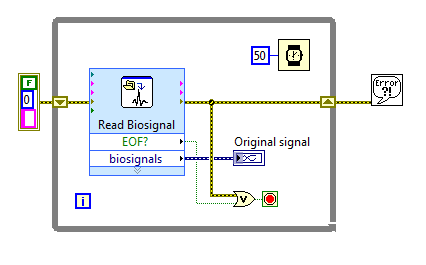From Friday, April 19th (11:00 PM CDT) through Saturday, April 20th (2:00 PM CDT), 2024, ni.com will undergo system upgrades that may result in temporary service interruption.
We appreciate your patience as we improve our online experience.
From Friday, April 19th (11:00 PM CDT) through Saturday, April 20th (2:00 PM CDT), 2024, ni.com will undergo system upgrades that may result in temporary service interruption.
We appreciate your patience as we improve our online experience.
![]()
This document is to teach you how to use the NI LabVIEW Biomedical Toolkit to import biosignals from different file formats.
In the biomedical engineering field, various file formats are created by different organizations and companies. It can be very difficult to work with a new file types in LabVIEW, especially complex file formats with headers and binary data. Sometimes we can use an application provided by that company or organization to save the data to acsii/txt file. However, this often results in losing important file information, can be really time consuming and the data file created can be hundreds of times bigger.
Simplify the use of many different common file formats using the same code. This would be amazing, right?
The current file load feature in Biomedical Toolkit supports following file types:
After you install the Biomedical Toolkit, you will find Read Biosignal Express VI under Biomedical->File IO.

Drop this Express VI to you block diagram, and a dialog will be displayed. Select the file you want to open, and then choose channels. You can select multiple channels to import. Browse to the time you want to start at (or input in Current start), and set a proper window size (or input in Window). The biosignals will be imported block by block, with block size defined by window size.
If the file has annotations or comments, you can check Output all annotations/comments to import annotations or comments while importing file. You can show annotations or comments in the graph to preview and configure the annotation type.

After configuration has completed, click OK to close the dialog. Create an indicator at biosignals and add a while loop outside the Express VI.

Run this VI, you can see the biosignal being imported block by block.
You can do some signal processing when importing biosignals, such as filtering using Biosignal Filtering VI

Run this VI, you will see the original and filtered signal in the front panel.

can it read large data with text file?thanks
Text file is not a supported file format since it is too general. What do you mean by text file here? Is it LVM file?
Thanks!
ZJ Gu
Actually I need to analyse Real time Clinical EEG signals so I want to know in what format EEG Signals can be given as input ?
Hi all, I am having a minor issue with the Read Biosignal VI. I have a TMX-18 that produces *.dcr files. When i have this VI read the file, it takes over ten minutes to read a 1GB file. it stores all of the data in memory at once before outputting any of it despite specifying that it should output in 1 second increments. With TDMS files, the VI only keeps 1 second of data in memory at a time before outputting. Is there anything i could do to resolve this? It is causing me some trouble on a low memory computer.